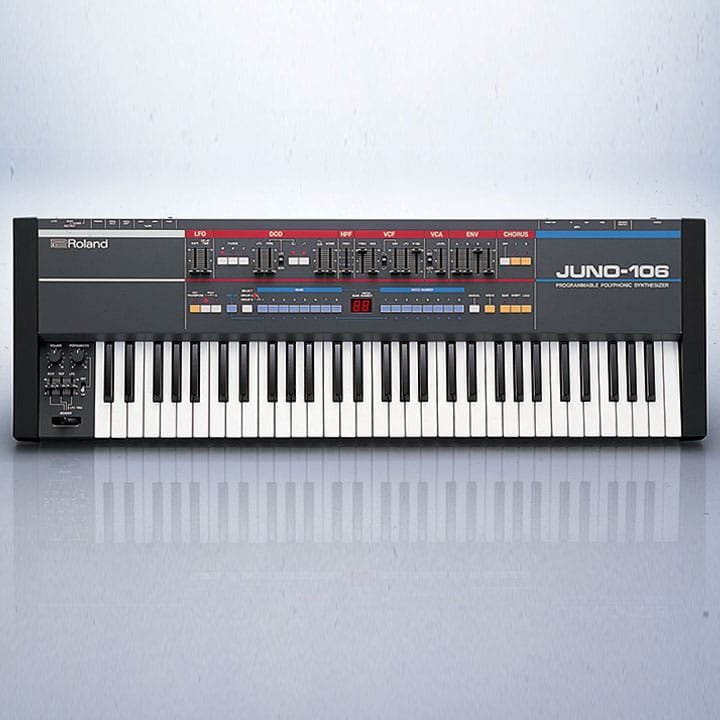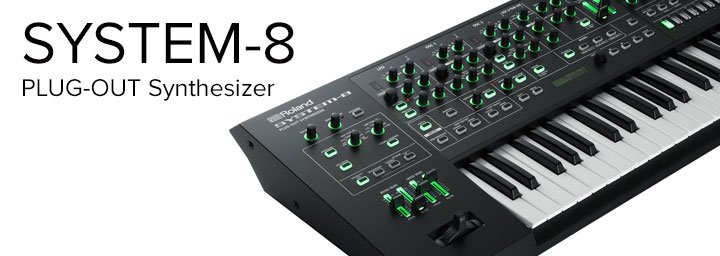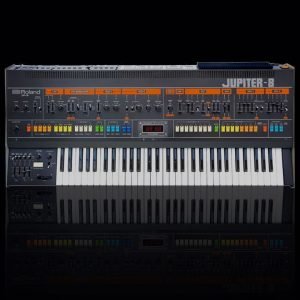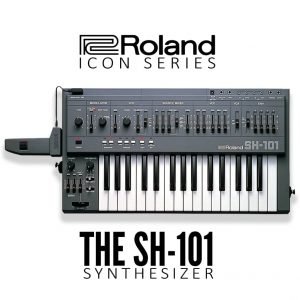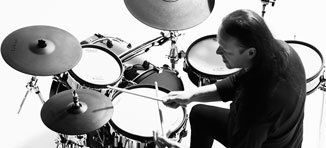The Roland Icon Series is a collection of articles looking back at the most popular and recognised Roland instruments. In over four decades, Roland has designed many world-first instruments like the first touch-sensitive keyboard and first guitar synthesizer.
Previous articles in the Roland Icon Series revisited the classic Roland Jupiter-8, the SH-101, the MRS-2 ProMars, the SH-2 Monophonic Synthesizer and the SYSTEM-100 Synthesizer. This article looks at the famed Roland Juno-106.
Contributed by Hannah Lockwood for Roland Resource Centre
THE JUNO SERIES
By the early 1980s, Roland had pioneered synth design with a now legendary range of monophonic, modular and polyphonic analog synthesizers. These included the aforementioned SH, System, MRS and Jupiter series. With the release of the Juno series in 1982, Roland continued to innovate with a new line of synthesizers that not only defined the sound of that decade, but provided a source of inspiration for musicians from all backgrounds. Our focus here, the Juno-106, was the third release in the Juno series of analog synthesizers which were manufactured and released during the early 1980s.
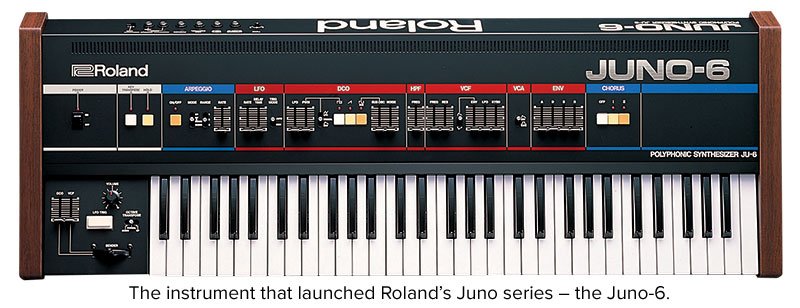
The first synthesizer in the Juno family, the Juno-6, was released in May 1982, marking the start of an incredible legacy that still continues today. The Juno series were the first synthesizers to use digitally controlled oscillators (DCOs) and the core part of this setup was the NEC μPD8253 chip (first used in an early electric piano called the EP-09). Continuing the polyphonic capability that Roland first utilised in 1979’s Jupiter-4, the Juno-6 offered six voices of polyphony and an array of onboard controls. Although it featured no MIDI and provided no patch memory storage, the Juno-6 is still coveted for its warm analog oscillators, distinctive chorus effect and superb filters. The Juno-6 did not feature any external control inputs or outputs, though did offer a VCF control input for sweeping the filter cutoff.
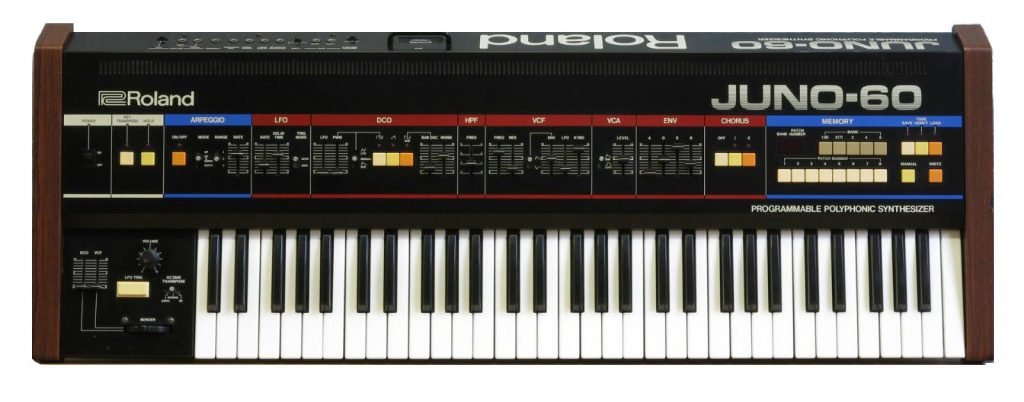
Similar in appearance, sound and internal architecture to the Juno-6, the Juno-60 was released in September 1982, offering new features that improved upon its predecessor. Patch storage memory was introduced, enabling the user to save up to 54 patches. It also featured the Roland Digital Control Bus (DCB) interface, which allowed the Juno-60 to be connected to other external instruments and sequencers. These additions made it favorable with live musicians and bands, who benefited greatly from the patch memory and connectivity.
February 1984 saw the release of the Juno-106, a direct descendant of the Juno-60 synthesizer. MIDI was introduced and patch memory was improved from 56 patches to 128, allowing for more expansive control. The simple up/down arpeggiator included on the earlier Juno models was replaced by a portamento feature. The Juno-106 offered the best of both the analog and digital worlds, and was one of the last great synthesizers to include a dedicated control for every parameter on the faceplate, for immediate access to all programming. Its ease of workflow and tactile interface made it popular with recording artists and live performers.
ONBOARD
The Juno-106 is a programmable, six-voice polyphonic, analog, subtractive synthesizer. With its relatively simple voice architecture, it is able to produce luscious soundscapes, rich basslines, strings, pads, pianos, leads and percussive sounds. Its intuitive interface and diverse sonic palette has inspired musicians from all styles and backgrounds.

Oscillators
The Juno-106 uses six digitally controlled oscillators, capable of producing a sawtooth, pulse and sub-octave square waveforms. DCOs were introduced into Roland synth design during the 1980s, as a means of eliminating inaccuracies such as pitch drift, which arose from the use of the completely analog VCOs in earlier synthesizers. DCOs provided a cheaper and more stable alternative to VCOs, without compromising the overall sonic character of the instrument’s analog sound. These were the same kind of control oscillators that were used in Roland’s famed JX-3P synthesizer.
The sawtooth waveform of the Juno-106 outputs directly from the DCO core, while the pulse wave is derived from the sawtooth, via a wave-shaping circuit. Even though these oscillators are digitally controlled and digitally stable, they produce true analog outputs with no digital stepping. Pitch is selectable via 16′, 8′, and 4′ settings. A square wave sub-oscillator and a noise generator are also provided, with individual sliders to control the levels for each parameter.
The Juno-106 features control for pulse width modulation (PWM). When the PWM switch is set to MAN, the pulse width can be manually set to a certain ratio. In this setting, the PWM slider controls the actual pulse width. When the PWM switch is set to LFO, the pulse width is controlled by the LFO signal. The PWM slider now controls the intensity of the LFO modulation.
Assign modes
The Juno-106 offers two Assign modes – Poly 1 and Poly 2. Poly 1 turns the Juno-106 into a six-voice polyphonic synthesizer, assigning one synth voice to each key that is pressed. This particular setting is generally suited to sounds with envelopes similar to a piano or a guitar and is recommended for standard use. Poly 2 mode is similar to Poly 1, the key advantage being that only the last note or notes played receive natural release length. This makes Poly 2 mode more suitable for performance with the onboard portamento effect. Pressing Poly 1 and 2 moves the Juno-106 into Solo Unison mode. In this mode, the Juno-106 acts as a monophonic synthesizer, with all six voices assigned to each key that is pressed.
Filters
Perhaps one of the most revered features of the Juno-106 is its 24dB/octave analog low-pass filter, which provides the instrument with much of its distinctively smooth texture and deep sonic power. The voltage controlled filter (VCF) features adjustable sliders for frequency and resonance level and can be modulated by one of the envelopes, the LFO, and keyboard tracking. Individual sliders for ENV, LFO and KYBD control the modulation level of the three sources. Using the KYBD control, the filter cutoff can track the keyboard, allowing for higher harmonics to be heard on notes with higher pitches.
The VCF has self-oscillating abilities, making it a vibrant and diverse analog filter. In addition to this, the Juno-106 also features a non-resonant high-pass filter (HPF), with four control positions and a dedicated slider for cutoff frequency.
The VCA of the Juno-106 can be switched between simple note gating or envelope controlled loudness, via a switch on the faceplate. A single invertible ADSR envelope can be assigned to the cutoff frequency of the filter, and can also be selected to control the VCA. A triangle wave LFO features controls for rate and delay and can be applied to both the DCO and VCF sections.
Control
The 106 was the first of the Juno series to offer MIDI capabilities, a feature which helped to elevate the Juno-106 from its predecessors at the time of its release. The back panel also features one set of 1/4” audio outputs, a stereo headphone jack output, a tune knob, patch shift and pedal hold jacks, a level switch, power ON/OFF, a memory protect switch and a MIDI function selector switch. The Tape interface located on the back panel allows the user to save and load patch programs onto a standard tape recorder via their respective jacks.
The onboard chorus effect of the Juno-106 was based on a set of bucket brigade delay (BBD) lines that were similar to other Roland products of the time, including the BOSS range of guitar pedals and effects units.
With its simple architecture – pulse and sawtooth waves, a square wave sub-oscillator, noise source, LFO, high-pass filter, VCF, ADSR and chorus effect – the Juno-106 has gone on to shape various music styles and genres. While other synthesizers offer more elaborate voice architecture, more complex envelopes and more diverse modulation capabilities, the relative simplicity of the Juno-106 makes its diverse sonic range quite amazing. Despite its limitations, it is still one of the most revered synthesizers of all time.
5 KEY FEATURES
The Juno-106 introduced some notable features to achieve its unique character sound.
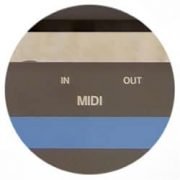 1. MIDI
1. MIDI
16 MIDI channels are available on the Juno-106 and MIDI SysEx Data is both transmittable and receivable from all sliders and buttons on the instrument. MIDI IN/OUT/THRU ports are located on the back panel. This allows for complete remote control and external sequencing capabilities. The Juno-106 offers three different types of MIDI modes, which can be changed via the MIDI Function switch on the back panel. These modes are:
- I – KYBD (Keyboard and Hold data only)
- II – KYBD + BENDER + PGM CHANGE (Keyboard, Hold, Bender, Patch selection data)
- III – ALL (All data, which includes SysEx). This allows for more advanced settings to be saved and changes to be made.
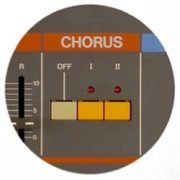 2. CHORUS
2. CHORUS
The Juno-106 features an onboard, stereo, two way, analog chorus unit, which produces its distinct character sound. The one-oscillator design left the Juno synthesizers sounding relatively thinner than their two voice counterparts. To make up for the single voice oscillators, Roland engineers employed a number of solutions to accommodate this design feature. The chorus effect provides a rich, spatial quality and is extremely effective in thickening sound sources. Few could predict that this chorus effect would go on to become a defining feature of the Juno sound, with legions of admirers worldwide. The Juno-106 offers two depths of chorus, with Chorus II creating a stronger effect than Chorus I.
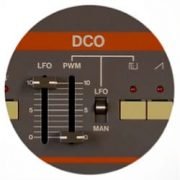 3. DIGITAL CONTROL, ANALOG SOUND
3. DIGITAL CONTROL, ANALOG SOUND
The DCOs used throughout the Juno series had a vast impact on the sound and usability of the Juno-106. DCOs were first used by Roland on the Juno-6 and proved to be more reliable than their purely analog voltage controlled equivalents. A digitally controlled oscillator derives its pitch directly from the main microprocessor in the form of digital pulses. These pulses are electronically shaped to provide the character waveforms. Although they are digitally controlled, they still produce a true analog output and retain the analog character of the instrument, with the benefit of digital stability. DCOs were one of the key components that allowed Roland engineers to greatly reduce the price point of the Juno series, catering to a new market of synth lovers.
 4. PORTAMENTO
4. PORTAMENTO
The Juno-106 features a portamento function, the first synthesizer in its price range to do so. Portamento allows for sliding from one pitch to another. This function allows the Juno-106 to produce polyphonic portamento, and is a useful tool for both live performance and studio work. It was a relatively rare feature at the time of release and gave the Juno-106 a distinct edge that set it apart from its competitors. The portamento knob of the Juno-106 determines the time required to change pitches.
 5. PATCH MEMORY STORAGE
5. PATCH MEMORY STORAGE
The Juno-106 can store 128 memory patches. Patch memory allows for keyboard and front-panel control changes, patch storage, and other display information. Patch presets store portamento and modulation settings, as well as slider settings. The Juno-106 also features a battery backup circuit, to retain the programs even when the synthesizer is switched off. Patch editing can be used as a real time performance control. Patches can be stored to, or loaded from a standard cassette tape.
JUNO INSPIRED
The Juno Series has undergone numerous reconfigurations in its extensive history. Shortly after the release of the Juno-106, Roland released a version equipped with built in stereo speakers; the Juno-106S. It offered the same front panel control and voice architecture, with the addition of a music stand, making it suitable for home musicians. Released in Japan, it was launched worldwide as the HS-60 Synth Plus 60. Both synthesizers share the same circuit board design and internal architecture. The HS-60 took on a more subdued front panel design, which was perhaps a way of marketing it more clearly for home use.
The JU-06 Sound Module, released in 2015, is a direct reincarnation of the Juno-106. As part of the Boutique series, it was created using Roland’s new ACB technology for the most accurate digital recreation of the Juno-106 sound. This limited addition, battery powered sound module has 4-voices, with 23 parameters controllable via the front panel.
In 2019, Roland launched the JU-06A, combining the best of the JUNO-60 and JUNO-106 in one synth. It has the continuous high-pass filter of the 106, the envelope-controllable pulse-width-modulation of the 60, and the unique filter behavior of both, instantly switchable from the front panel. The sound is indistinguishable from its vintage counterparts, even while tweaking controls or using extreme settings. And being faithful to the vintage JUNO, it also has the swirling sound of its legendary chorus, faithfully recreated, right down to the lovable (and thankfully adjustable) noise.
The JU-06A includes arpeggio, chord memory, and step sequencer. While you may prefer the filter of the JUNO-106, you might miss the arpeggio function on the JUNO-60. The JU-06A has both—and includes chord memory and an onboard sequencer. Creating sequenced lines with chord memory results in incredibly thick sounding polyphonic phrases.
PLUG-OUT
The character sound of the Juno-106 synthesizer is now also available for the AIRA SYSTEM-8. All of the original tones, features and sounds described above are now accessible via the JUNO-106 PLUG-OUT.
With the JUNO-106 PLUG-OUT synthesizer, the sound of this classic, vintage instrument is faithfully reproduced with Roland’s Analog Circuit Behavior (ACB) technology. ACB recreates the sound and feel of the most admired Roland instruments, using original design specs, and a detailed, part-by-part analysis of each analog circuit.
The SYSTEM-8 allows for three separate PLUG-OUTs to be loaded at one time, alongside the original SYSTEM-8 synth engine. Use the new JUNO-106 PLUG-OUT with the SYSTEM-8 to take your vintage Juno sound to the stage, with additional versatility and reliability.
The Juno-106 is the latest legendary Roland synthesizer to be reproduced in a range that includes the JUPITER-8, the SH-101 PLUG-OUT, the MRS-2 ProMars PLUG-OUT, the SH-2 PLUG-OUT and the SYSTEM-100 PLUG-OUT.
https://www.roland.com/au/products/rc_juno-106/
Now you can have the JUNO-106 software synthesizer on your computer with Roland Cloud!
Plug In Your Own JUNO-106
Roland Cloud is the only authentic software resource for the true JUNO-106 sound. While the original hardware version is scarce, expensive, and in need of frequent tune-ups, our plug-in is always ready to play, whenever you need it. There are some great feature enhancements too, which are only available in the virtual instrument:
- Eight voices of polyphony
- Condition knob adjusts the sound of the JUNO-106, from clean and pristine to warm and broken in
- Two fully adjustable envelopes
- Famous JUNO chorus, plus modern reverb and tempo-syncing delay
- Onboard tempo-syncing arpeggiator
Hardware Integration
The JUNO-106 also supports our PLUG-OUT format for extended operation with Roland’s SYSTEM-8 hardware synth. Parameters are automatically mapped to the SYSTEM-8’s controls, giving you a full-featured JUNO-106 you can take to the stage without a computer. It’s also possible to use the SYSTEM-8 or a Roland Boutique JU-06/JU-06A for one-to-one, hands-on control of the JUNO-106 software plug-in.
There are over 50 Roland virtual instruments available to you and you can also embrace the future with the new ZENOLOGY plug in. Share your sounds across software and hardware with the ZEN-Core Synthesis System. Also, keep your music fresh with genre-specific patches, patterns, and sound packs. There is a choice of membership tiers including free. Click here to find out more about Roland Cloud.
Roland Icon Series: The System 100 Synthesizer
Roland Icon Series: The SH-101 Synthesizer
Roland Icon Series: The Promars Synthesizer
Roland Icon Series: The SH-2 Synthesizer
Roland Icon Series: The Jupiter-8 Synthesizer
Roland Icon Series: The D-50 Linear Synthesizer
Roland Synth Chronicle: 1973 through 2013
The A-to-Z of Synthesizer Terms
Synthwave, SCI FI and Sound Design

